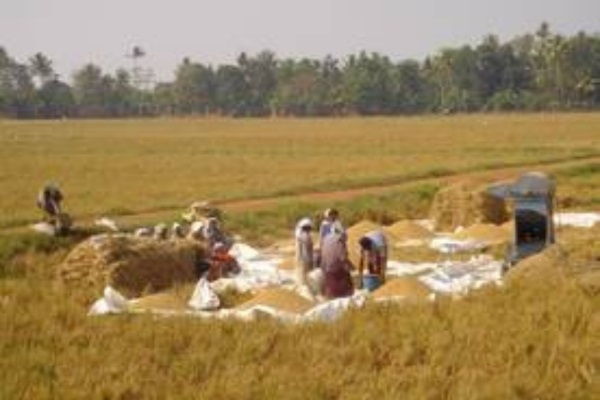Kuttanad Below Sea Level Farming System, India
GIAHS since 2013

Photos courtesy of Kuttanad Below Sea Level Farming System, India
Kuttanad Wetland Agriculture System is below sea-level, created by draining delta swamps in brackish waters. The system is a complex mosaic of fragmented agricultural landscapes divided in three structures: wetlands used for paddy activities and fish catching, garden lands used for food crops plantation and water areas used as inland fishing and shells.
Global Importance
Kuttanad Wetland Agriculture System is unique, as it is the only system in India that favours rice cultivation below sea level in the land created by draining delta swamps in brackish waters. This system also allows fisheries systems, livestock and home garden to be grown. The system of below sea-level farming is an approach to cope with the imminent climate impacts in coastal areas and evolve efficient methods to deal with soil and pest-related issues in agriculture.
Thus, protection of this fragile and unique system from any external pressure is important and urgent for humanity as it is essential for maintaining and enhancing so much endemic biodiversity and several vital ecosystem services for human well-being worldwide.
Food and livelihood security
Agriculture and Inland Fisheries are the major land/water use practices of the system, which considered as the largest wetland use system in the west coast of Indian peninsula. First of all, the Kuttanadan rice production share about 25% io the State’s total rice production and is the stable food of the farmers.
Moreover, the system allows duck farming in a promising way. Immediately after harvesting the rice, ducks are brought in even from distant places to the fields insuring a direct food and manure supply for the farmers but also as a source of income.
Divided in several landscapes, this system full of estuaries, flood plains, Kayals, ponds and canal networks are known for its diverse fish and shells wealth. Not only for self-consumption production, Kerala now produces 2,000 tonnes of Karimeen, an endemic fish from the Region and clams.
Biodiversity and ecosystem functions
Shaping different kind of landscapes, this system forms habitats for agro and wild biodiversity. First of all, due to mixed agro-systems, different species of cultivated plants such as rice, coconut palm, vegetables, but also local shells and fishes are found. Besides, local duck breeding is part of the system.
Concerning the wild life, thanks to the diversity of created landscapes, fishes, insects, turtles and birds can find in this system their natural habitats with food supply coming from the cultivation of the system. The region is a large repository of migratory endemic fish species and birds. However, it has been reported that over the last thirty years, the fish diversity has reduced from 150 spp. to 36 spp. and many are reported as critically endangered or even extinct in the region.
Knowledge systems and adapted technologies
The Kuttanad system is a complex mosaic of fragmented agricultural landscapes divided in three structures: wetlands used for paddy activities and fish catching, garden lands used for coconut, tubers and food crops plantation and water areas used as inland fishing and shells.
Being the first step of this system, water sources needs to be reoriented by the construction of polders to create cultivable lands. Bunds are constructed thanks to coconut coproducts, sand, twigs and high quality clay. These bunds are often strengthened in accordance with the level and force of floodwaters.
After constructing the bund, the polder area is dewatered. The water is generally pumped out thanks to oil engines or electric motors. Once the dewatering is completed rice cultivation process starts. Moreover, farmers prefer a rice-fish rotation when the paddy turns to be less lucrative. It also helps reducing diseases and weeds pressure. Immediately after harvesting the rice, ducks are brought to the fields.
Cultures, values systems and social organizations
Living in a wetland area is part of the culture. Plants and animals present in the bushes in isolated patches and water are employed in various ways for their special dishes and agricultural needs. Moreover, a deep knowledge of wild plants is still alive in the region.
Abundantly grown, screw pines and a sedge Typha in the region offer enough raw material for Mat weaving – a livelihood option for the women in earlier days. It is a fast fading tradition now along with many other natural and bio-resource dependent heritage practices.
Concerning the social organization, the padasekhara (field) committees are made responsible for the annual maintenance of bunds. Individual farmers of each padasekharam, on the basis of the area they own, share the cost of the maintenance work of the bunds.
Remarkable landscapes, land and water resources management features
The landscape composition, structure, management and the regional context of Kuttanad are unique and significant. The area is a larger mosaic of fragmented landscape patches and varied ecosystems such as coastal backwaters, rivers, vast stretches of paddy fields, marshes, ponds, garden lands, edges, corridors and above are remarkably networked water ways.
For the water management, a crucial regulating service is played in the control of the hydrology of the entire region controlling flood during monsoon and drought in summer season.
Proposal

Proposal: Kuttanad Below Sea Level Farming System, India
02/05/2013
Kuttanad Below Sea-level Farming System (KBSFS) is unique, as it is the only system in India that practices rice cultivation below sea level.
Multimedia

Photos
Flickr Album: Kuttanad Below Sea Level Farming System, India
05/08/2020
The Kuttanad system is a complex mosaic of fragmented agricultural landscapes divided in three structures: wetlands used for paddy activities and fish...

